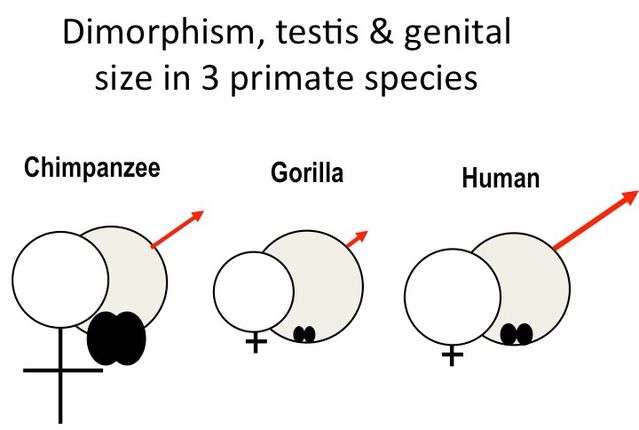Sex
It’s the Mode for Men to Have More Sex Partners
Examining the averaging fallacy.
Posted March 2, 2017 Reviewed by Ekua Hagan
A recent post asked how men could report more sex (and sexual partners) than women do. Let me pose another question: Why aren’t we all limping because on average we have slightly less than two legs?
You’re probably wondering how people could on average have less than two legs. The answer of course is that, while the vast majority of people have two legs, a few have only one, and fewer still have none at all. But no one has three or more legs, so the mean number of legs for human beings is very slightly less than two. Nevertheless, the mode—the most frequently found number of legs—is indeed two.
You need to make the same distinction to resolve what you might call the averaging fallacy with regard to the number of sex partners. This holds that "for heterosexual pairings, the number of partners simply has to even out. The discrepancy arises from men’s tendency to exaggerate and women’s fear of derogatory labeling."
But consider a community of 10 monogamous heterosexual couples. If 1 woman has sex with all the other men but all the other women don’t, we now have a situation where 9 men have 2 partners, and 9 women have only 1, while the cuckolded man also has 1. The mode for the men is 2, the mode for the women is 1, and the mean is 1.9 for both sexes.
But no one has sex with .9 of a partner, so this in itself should tell you that this is an abstraction and not a real figure.
What about real behaviour? According to the National Survey of Sexual Attitudes and Lifestyles of 18,876 British people 1990-91, twice as many women (39.3%) had only 1 sexual partner during their lifetime compared to men (20.6%); while 24.4% of all men had more than 10 sexual partners compared to 6.8% of women. One percent of men accounted for 16% of all partners in the previous 5 years. Of 11,000 people aged 16-44 surveyed in 2001, average number of relationships in the previous 5 years was 4 for men and 2.5 for women. Men had on average 13 lifetime partners, while women had exactly half that. Of men, 14.6% had more than one sexual relationship at the same time, but only 9% of women did.
Homosexuals conform to the pattern: Gay men typically have more partners than lesbians, and one study in San Francisco found that nearly 50% of gay men had more than 500 partners. According to Camilla Paglia, “Gay men seek sex without emotion; lesbians often end up with emotion without sex!”
If the averaging fallacy were true, it would have enormous significance for evolution because it would mean that there could be no variance of reproductive success between the sexes: In other words, contrary to the actual case, males and females would averagely have the same number of offspring. And if this were true, Darwin would have been wrong about sexual selection—not spectacularly right, as he proved to be, despite having been supposed wrong for the best part of a century.
Indeed, even what Darwin could not actually explain at the time—heredity—bears him out. Most indigenous societies in Africa are polygynous and institutionalize males having more sex partners in marriage. The result is that in Ghana the average father has twice as many children as the average mother. And because the Y chromosome is only inherited from the father and mitochondrial genes only from the mother, in Sinai Y genetic diversity is low while that of mitochondrial genes is high. But how could this be if the real number of partners for the sexes was actually equal?
Furthermore, you can see the modal number of partners in the anatomy of ourselves and our near relatives. In the slide below, the mean body size of males relative to females (so-called sexual dimorphism) is represented by circles for each species. Male and female genital size is also shown, along with the relative size of the testes in each species.

In chimpanzees, modal numbers of sex partners are generally high for both sexes, which selects for a large female genital display, low sexual dimorphism, and very large testes because many males mate with each female, and the only way that they can compete is inside the female's reproductive tract: hence the need for more high-quality sperm. So for chimps, the claim that the sexes are equal in the number of sex partners may well have much truth in it, especially for bonobos, who are known to be highly promiscuous.
In gorillas, however, sexual dimorphism is pronounced because silverback alpha males monopolize harems of females, whose genitals are small, as are those of the males. Most significantly of all, the testes too are small because there is no sperm competition in such a situation.
Humans appear to be between the two: more dimorphic than chimps, but less so than gorillas (with penises which are the largest of all, partly perhaps because they lack a penis bone). But the relatively small size of human testes and of female genitals is comparable to what you find in the highly polygynous gorilla.
Did I miss anything? Are there other explanations for why the genders differ in reported amounts of sex? Oh yes, you did, and oh yes there are!
But let me ask this: Would this fallacy be so widely believed if things were the other way round, and it implied sexual inequality? I know what I think.




